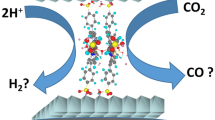Abstract
IronIII sulfophenyl phosphate (FeSPP) is successfully synthesized by an optimized process from the reaction of ironIII chloride and m-sulfophenyl phosphonic acid (msPPA) by a simple and environmentally friendly method. Experimental results show FeSPP has a kind of layered structure, and multilayer sheet is about 2 nm thick. FeSPP exhibits good thermal stability and does not decompose under 200 °C. Protons transfer through vehicle and Grotthuss mechanisms at different relative humidities (RH). The conductivity of FeSPP can reach to 0.115 S/cm at 180 °C and RH = 100 %. Under this condition, vehicle mechanism plays the leading role, and the Grotthuss mechanism plays the minor role. At low RH, Grotthuss plays the leading role, and vehicle plays the minor role. In a drying oven at 180 °C, the proton conductivity remains 2.15 × 10−3 S/cm. Good conductivities at different RH and thermal stabilities clearly demonstrate that FeSPP is a highly effective conductor. It can be used as catalysts, chemical sensors, and in the preparation of composite membrane.









Similar content being viewed by others
References
Shi D, Wei L, Wang J, Zhao J, Chen C, Xu D, Geng H, Zhang Y (2013) Solid organic acid tetrafluorohydroquinone functionalized single-walled carbon nanotube chemiresistive sensors for highly sensitive and selective formaldehyde detection. Sens Actuators, B 177:370
Hu Y, Fu X, Barry BD, Bi X, Dong D (2012) Regiospecific β-lactam ring-opening/recyclization reactions of N-aryl-3-spirocyclic-β-lactams catalyzed by a Lewis-Brønsted acids combined superacid catalyst system: a new entry to 3-spirocyclicquinolin-4(1H)-ones. Chem Commun 48:690
Williams LA, Marks TJ (2011) Synthesis, characterization, and heterogeneous catalytic implementation of sulfated alumina nanoparticles. Arene hydrogenation and olefin polymerization properties of supported organozirconium complexes. ACS Catal 1:238
Zheng A, Huang SJ, Liu SB, Deng F (2011) Acid properties of solid acid catalysts characterized by solid-state 31P NMR of adsorbed phosphorous probe molecules. Phys Chem Chem Phys 13:14889
Vasireddy S, Ganguly S, Sauer J, Cook W, Spivey JJ (2011) Direct conversion of methane to higher hydrocarbons using AlBr3-HBr superacid catalyst. Chem Commun 47:785
Dingwall LD, Lee AF, Lynam JM, Wilson K, Olivi L, Deeley JMS, Gaemers S, Sunley GJ (2012) Bifunctional organorhodium solid acid catalysts for methanol carbonylation. ACS Catal 2:1368
Tang Q, Yuan S, Cai H (2013) High-temperature proton exchange membranes from microporous polyacrylamide caged phosphoric acid. J Mater Chem A 1:630
Luo J, Conrad O, Vankelecom IFJ (2013) Imidazolium methanesulfonate as a high temperature proton conductor. J Mater Chem A 1:2238
Wang J, Zhang Z, Yue X, Nie L, He G, Wu H, Jiang Z (2013) Independent control of water retention and acid–base pairing through double-shelled microcapsules to confer membranes with enhanced proton conduction under low humidity. J Mater Chem A 1:2267
Thanganathan U, Bobba R (2012) Enhanced conductivity and electrochemical properties for class of hybrid systems via sol–gel techniques. J Alloy Compd 540:184–186
Yang M, Lu S, Lu J, Jiang SP, Xiang Y (2010) Layer-by-layer self-assembly of PDDA/PWA–Nafion composite membranes for direct methanol fuel cells. Chem Commun 46:1434
Duan XX, Liu Y, Zhao Q, Zhang X, Wang XH, Li SW (2013) Water-tolerant heteropolyacid on magnetic nanoparticles as efficient catalysts for esterification of free fatty acid. RSC Adv 3:13748
Thanganathan U (2011) Structural study on inorganic/organic hybrid composite membranes. J Mater Chem 21:456
Dong FL, Li ZF, Wang SW, Xu LJ, Yu XJ (2011) Preparation and properties of sulfonated poly(phthalazinone ether sulfone ketone)/zirconium sulfophenylphosphate/PTFE composite membranes. Int J Hydrogen Energy 36:3681
Mosa J, Larramona G, Durán A, Aparicio M (2008) Synthesis and characterization of P2O5-ZrO2-SiO2 membranes doped with tungstophosphoric acid (PWA) for applications in PEMFC. J Membr Sci 307:21
Hogarth WHJ, Diniz Da Costa JC, Lu GQM (2005) Solid acid membranes for high temperature (>140°C) proton exchange membrane fuel cells. J Power Sources 142:229–235
Li ZF, Dong FL, Xu LJ, Wang SW, Yu XJ (2010) Preparation and properties of medium temperature membranes based on zirconium sulfophenylphosphate/sulfonated poly(phthalazinone ether sulfone ketone) for direct methanol fuel cells. J Membr Sci 351:50
Alberti G, Casciola M (1997) Layered metalIV phosphonates, a large class of inorgano-organic proton conductors. Solid State Ionics 97:177–181
Dong FL, Li ZF, Wang SW, Wang ZH (2011) A novel inorgano-organic solid proton conductor material. Mater Lett 65:1431
Kim YT, Song MK, Kim KH, Park SB, Min SK, Rhee HW (2004) Nafion/ZrSPP composite membrane for high temperature operation of PEMFCs. Electrochim Acta 50:645
Kim YT, Kim KH, Song MK, Rhee HW (2006) Nafion/ZrSPP composite membrane for high temperature operation of proton exchange membrane fuel cells. Curr Appl Phys 6:612–615
Jin L, Li ZF, Wang SW, Wang ZH, Dong FL, Yin XY (2012) Highly conductive proton exchange membranes based on sulfonated poly(phthalazinone ether sulfone) and cerium sulfophenyl phosphate. React Funct Polym 72:549
Hwang M, Ha HY, Kim D (2008) Zirconium meta-sulfophenyl phosphonic acid-incorporated Nafion® membranes for reduction of methanol permeability. J Membr Sci 325:647
Jerus P, Clearfield A (1982) Ionic conductivity of anhydrous zirconium bis (monohydrogen orthophosphate) and its sodium ion forms. Solid state ionics 6:79–83
Park CH, Lee CH, Guiver MD, Lee YM (2011) Sulfonated hydrocarbon membranes for medium-temperature and low-humidity proton exchange membrane fuel cells (PEMFCs). Prog Polym Sci 36:1443
Acknowledgments
This work was financially supported by the National Natural Science Foundation of China (grant nos. 21276148, 21076119, and 20776081), the State Key Laboratory of Chemical Engineering (Tianjin University) (Grant no. SKL-ChE-14B01), and the Natural Science Foundation of Shandong Province, China (grant no. ZR2010BM004)
Author information
Authors and Affiliations
Corresponding author
Rights and permissions
About this article
Cite this article
Liu, G., Li, Z., Jin, L. et al. Simple synthesis of ironIII sulfophenyl phosphate nanosheets as a high temperature inorganic–organic proton conductor. Ionics 20, 1399–1406 (2014). https://doi.org/10.1007/s11581-014-1109-0
Received:
Revised:
Accepted:
Published:
Issue Date:
DOI: https://doi.org/10.1007/s11581-014-1109-0




